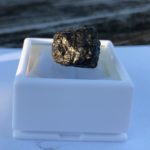Cite as: Benner, S. A. (2021) “Resurrecting the Past: From Molecules to Ecosystems”. Primordial Scoop, 2021, e0217. https://doi.org/10.52400/YGKQ3172
In Jurassic Park, scientists used biotechnology to bring dinosaurs back to life. A Jurassic mosquito bit a Jurassic dinosaur, and then got trapped with Jurassic blood in Jurassic tree sap. This sap fossilized to become amber, from which the dinosaur blood was extracted to get dinosaur DNA. Which was cloned using the magic of biotechnology.
But Jurassic DNA can be gotten in other ways.
The closest analogy comes from linguistics. The English words for “one-two-three” in German are “ein-zwei-drei”. In French, they are “un-deux-trois”. In Czech, they are “jedna-dva-tři”. This similarity in the sequence of the letters in the words reflects their common ancestry.
The Germanic, Romance, and Slavic languages all descended from a common language called Indo-European. By comparing the sequence of letters in the words in the descendant languages, linguists reconstruct the sequence of letters in the words that Indo-European school children used to count 5000 ± 500 years ago: “oinos-dwou-trejes”.
This kind of analysis offers a different way to do Jurassic Park experiments. For example, Belinda Chang was interested in how dinosaurs looked at the world. Birds are the modern descendants of the dinosaur known as the archosaur, which lived 240 million years ago. Belinda got the DNA encoding the visual pigment from the eyes of many birds, and inferred the sequence of the DNA encoding the visual pigment from the archosaur. She then used the magic of recombinant DNA technology to bring that protein back to life. Remarkably, the ancient visual pigment worked. A real Jurassic Park experiment.
Actually, the archosaurs lived in the Triassic. Tyrannosaurus also was not a Jurassic dinosaur. Spielberg was no scientist.
But such details become important if we hope to connect paleobiochemistry to real natural history. For example, we were interested in the paleoecology of ethanol, vernacularly known as alcohol. Alcohol is made when yeasts infect fruit like grapes. Once inside the grape, the yeast ferments the grape sugar to make ethanol using enzymes that have evolved for that purpose. Those enzymes are encoded by DNA in genes in the yeast, and there are many related varieties of yeast alive today.
So we could infer the sequence of the enzymes that the ancestral yeast had when it first began to ferment ~100 million years ago. We used the magic of recombinant DNA technology to clone a gene from the ancestor of modern yeasts, and we showed that the enzyme it encoded was actually able to ferment sugar. We may not know the origin of life, but we’ve got the origin of liquor.
However, while we were celebrating, we had a thought: Where did the fruits come from? The Cretaceous yeast must have had a Cretaceous home with Cretaceous fruit coming from a Cretaceous flowering plant? No?
And so we were delighted to read a report in December from a team at Oregon State University. of the discovery of a 99 million-year-old flower, also in amber, from Southeast Asia. That plant was an ancestor of the black heart sassafras that now lives in Australia. When that plant lived, Australia and Southeast Asia were connected as part of the supercontinent Gondwanaland.
There was the connection between our ancestral molecules and the actual ancestral plant.

David Dilcher and his colleagues in China recently extended the connection to insects. In another piece of amber from the same locale, they found a beetle that had pollen grains attached to it. The beetle, an animal, was pollenizing the flowering plant that was making the fruit that became the home of newly fermenting yeast. 100 million years ago.
Systems biology from the past. From the age of the dinosaurs, connecting metabolites like ethanol to the enzymes that made them to microbes that produced them to the plants that fed them to the animals that pollinated them. In an ancient ecosystem 100 million years from the past.
Why should the natural history of fermentation interest us? For one, fermentation played a major role in human evolution. But that was more recent. Resurrections of ancient human digestive enzymes responsible for oxidizing ethanol in our digestive tract emerged only about 7 million years ago, in the Pliocene (look it up). Long after yeast was fermenting fruits.
Our ancestors in the Pliocene were living in trees. There, they picked and ate fresh fruit. No yeast in these. And no ethanol.
But 7 million years ago, our ancestors decided to come down from the trees. Their legs became suited for bipedal walking. Their arms became suited to pick up fallen fruit. Very Biblical. And unlike fresh fruit, fallen fruit likely had a damaged husk. And the damaged husk likely allowed yeast to enter. And fermentation to begin.
So we needed to have digestive enzymes able to oxidize ethanol just as it was coming into our diet.
We are the products of our natural history. And the small specimens of amber from Southeast Asia provide pretty pictures of this heritage.


